Very large Arita blue and white transferware charger - Japan, Meiji period (1868-1912)

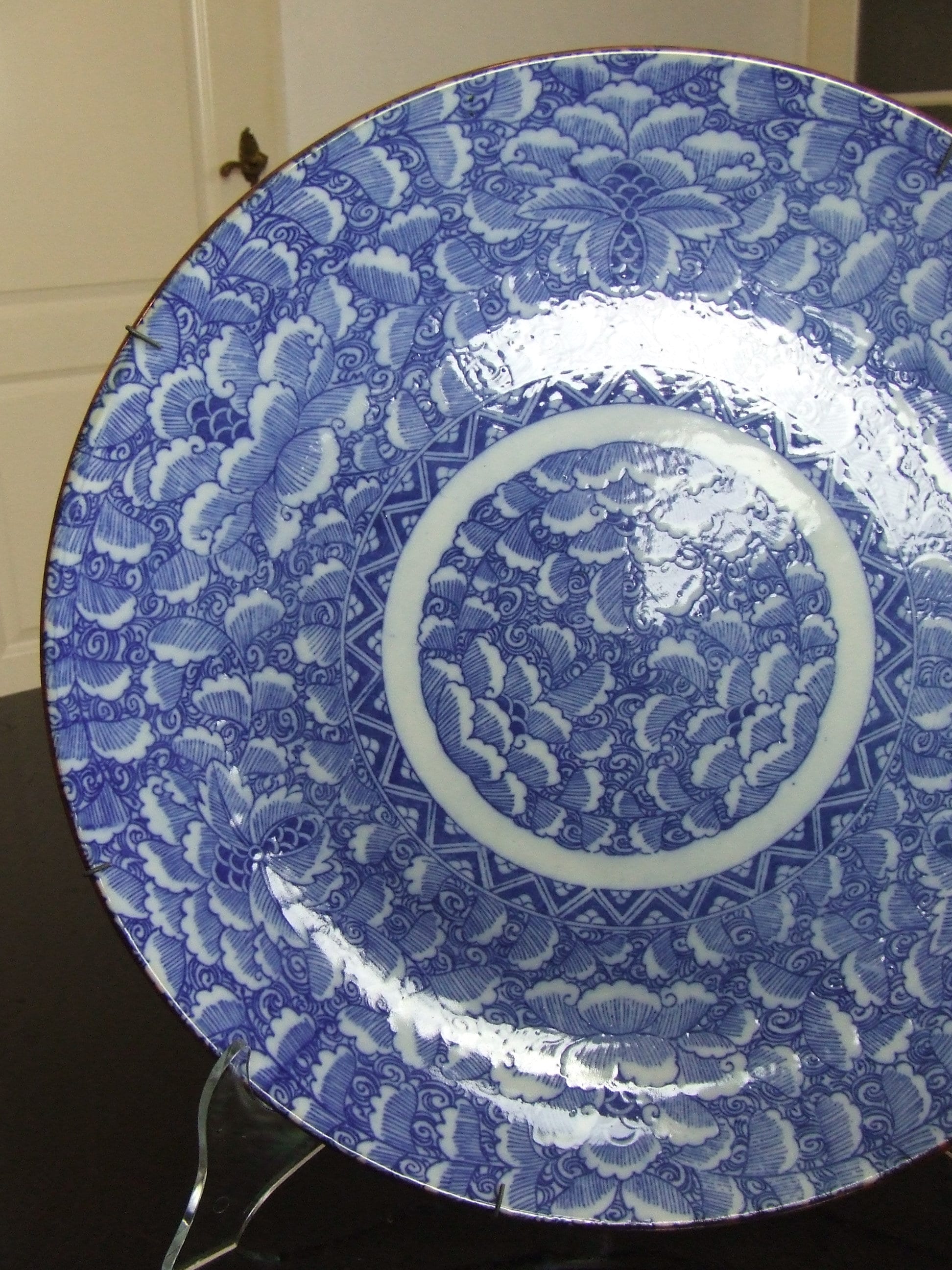
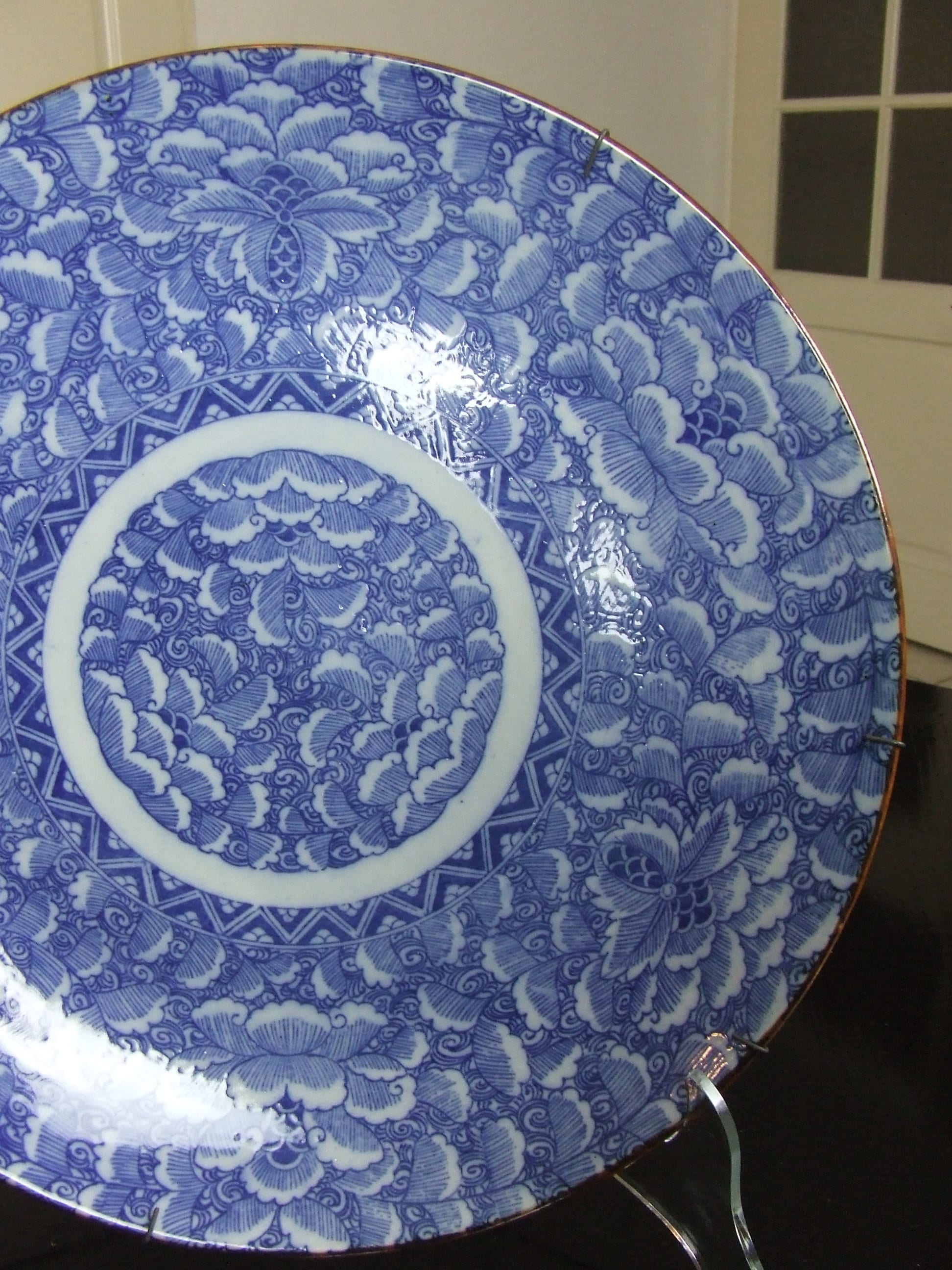

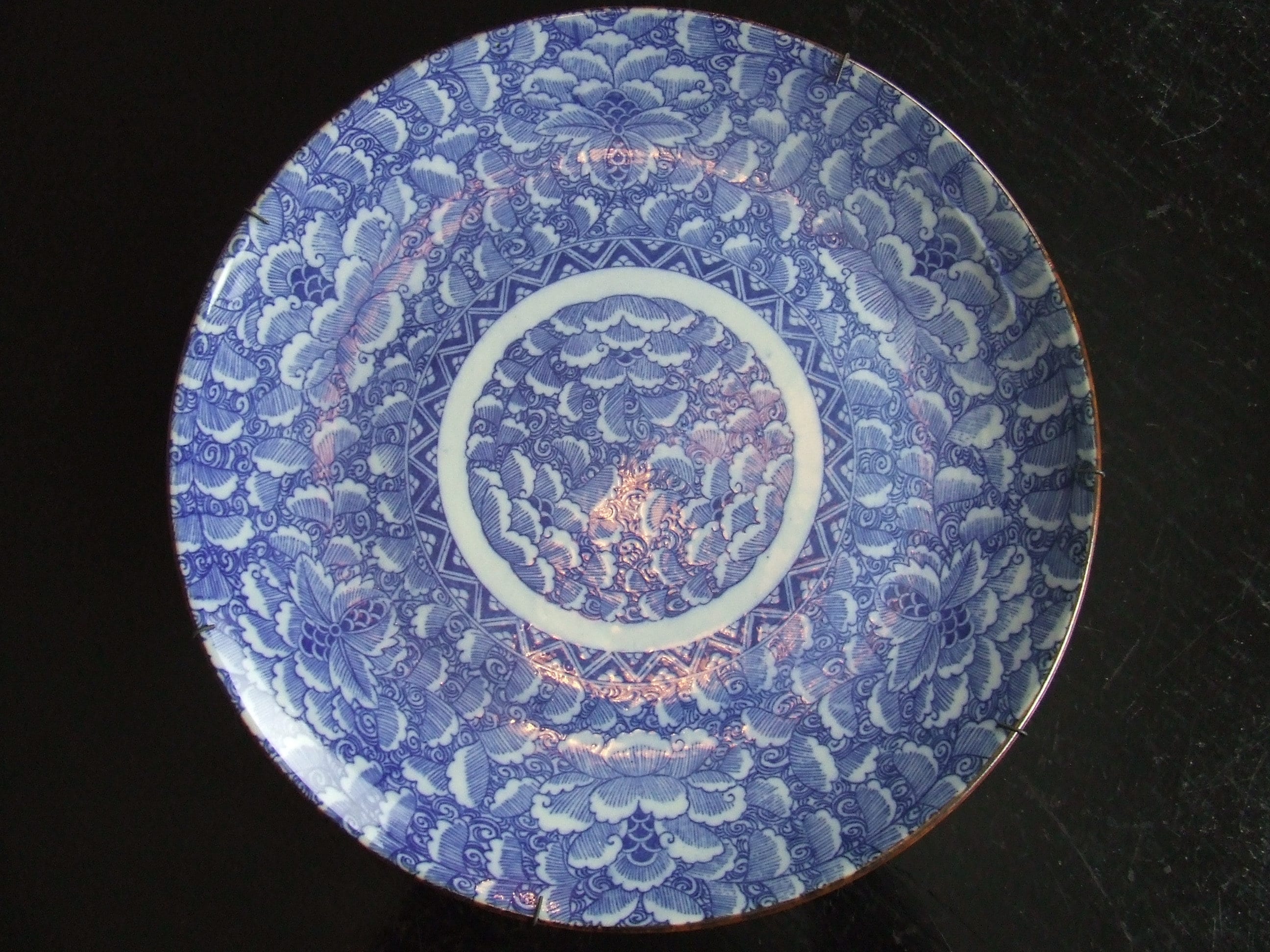
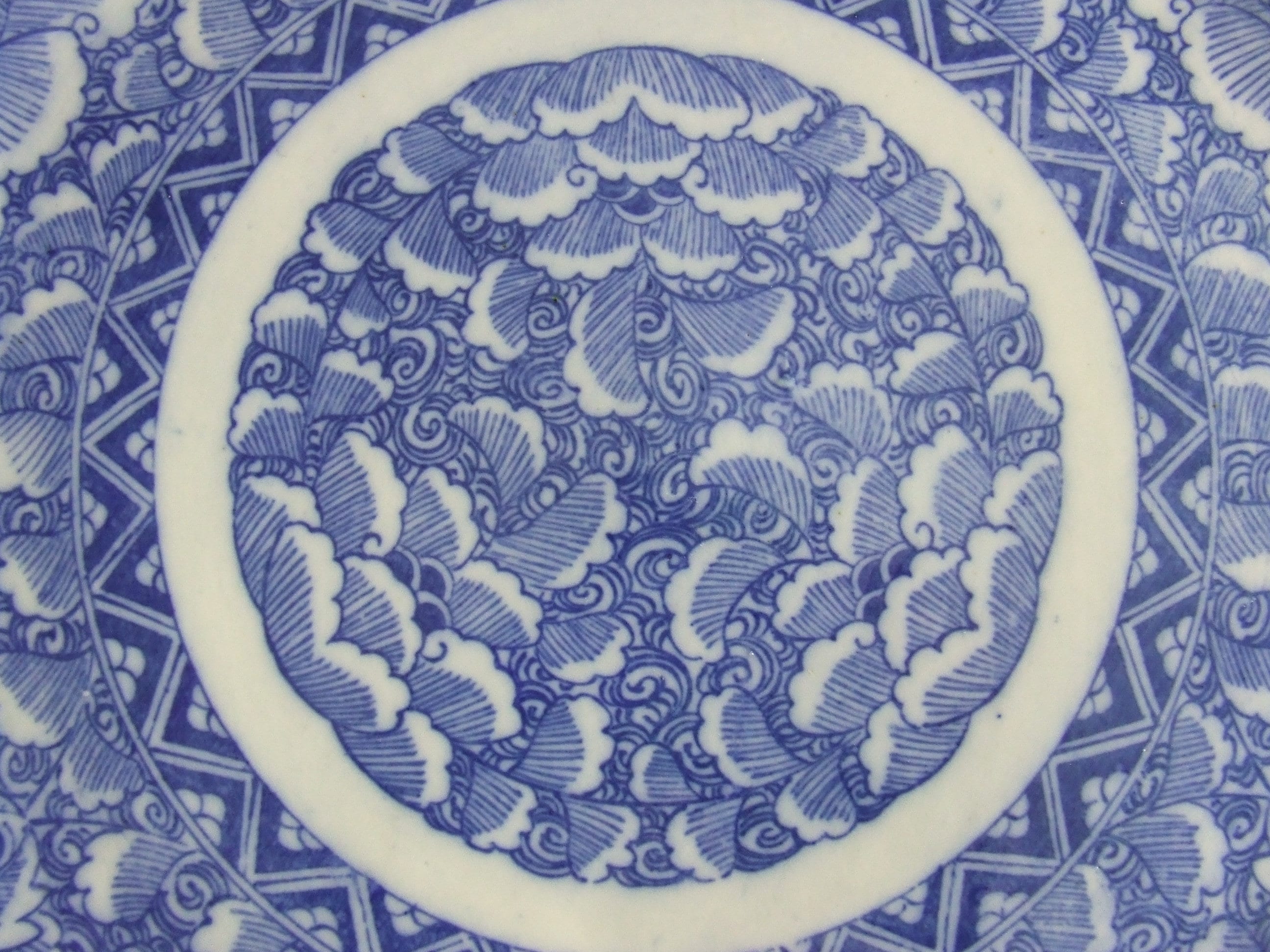
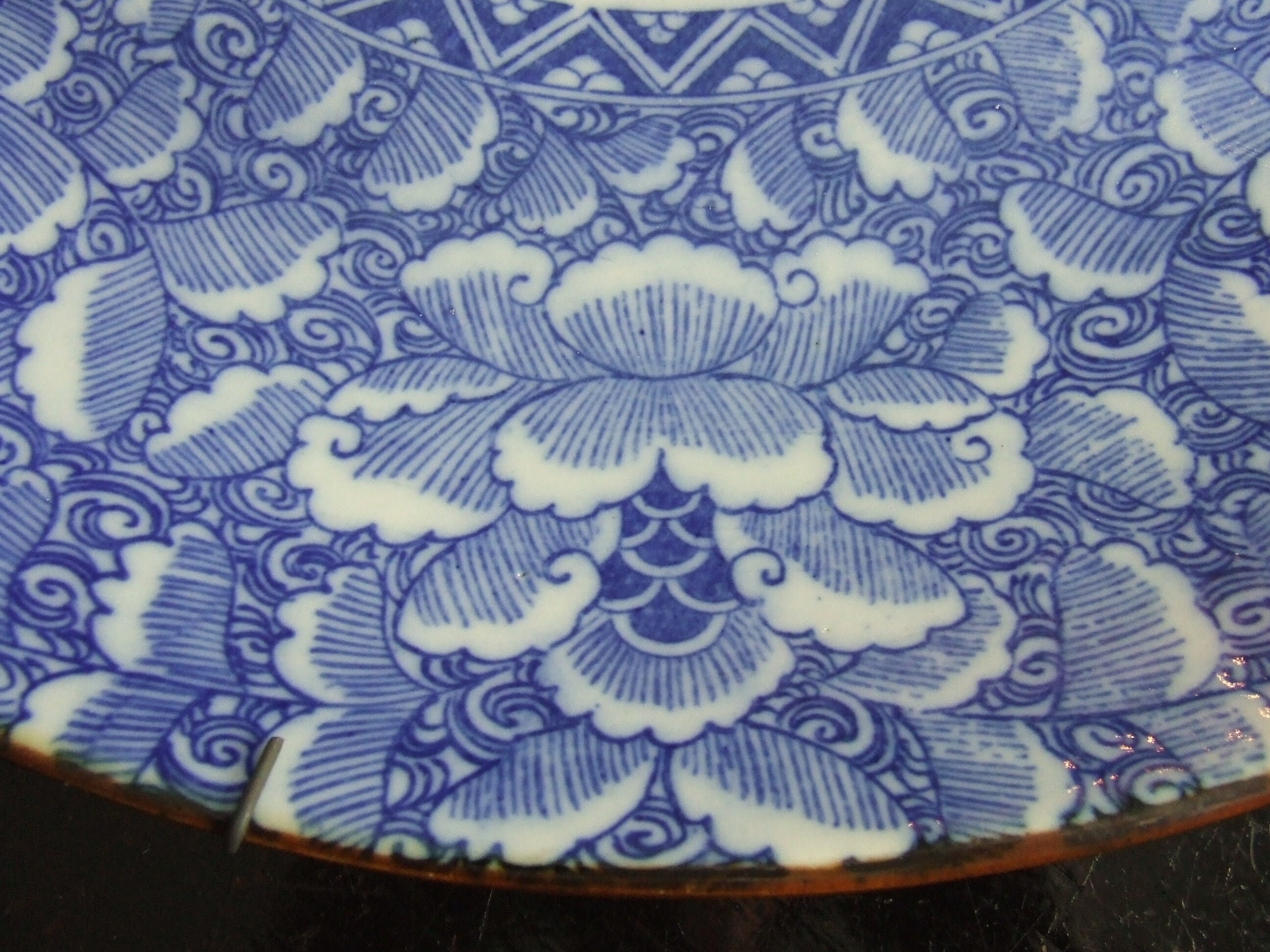

Beautiful very large (40,0 x 4,5 cm) blue and white charger made during the Meiji period (1868-1912) in Japan, most probably in the Arita area.
The charger is decorated with a geometric pattern of stylised leaf and fruit structures with filled in between structures of spiralled clouds or waves. The edge of the plate is painted gold-brown, similar to Igezara porcelain, but without its characteristic knobs / ribs. The backside of the plate is decorated with three circles and three leaf and flower ornaments. The plate comes with a metal plate holder which seems to be about the same age as the plate. It can be used to hang the plate on a wall.
Condition: excellent, there are no damages, cracks, hairlines or restorations. There is very little wear to the glaze, which is has a beautiful deep gloss. Also on the edges there is little wear, also not from the metal wires of the plate holder. There is no crazing of the glaze. The plate has several stilt marks on it back (five in its centre and at least two on its footring). These are marks of the stilts the plate was resting upon when it was fired in the oven. These rather large marks are a characteristic feature of the plates from this period.
A very beautiful and impressive Meiji period transferware charger in great condition. Great to hang on a wall, but also great as a centrepiece on a table, or placed in a plate stand. The perspex plate stand that is featured in the photos will be included with the dish. The metal wire holder can easily be removed if required.
Origin: Japan, most probably from the Arita area
Age: between 1868 and 1912 (Meiji period)
Method of decoration: transfer print applied by hand, some additional handpainting (circles on the back, the brown edge)
Size: diameter 40,0 cm, depth 4,5 cm
Weight: 2,08 kg (including plate holder)
Additional pictures can be provided if required.
----------------------------------------------------------------------
About the Meiji period:
The Meiji period is a period in Japanese history that lasted from 1868 to 1912. At this time Japan began to open up towards the West and embrace Western ideas and technologies. The government implemented sweeping reforms in areas such as education, law, and the military, and encouraged Japanese businesses to adopt Western-style industrialization practices.
The Meiji period also saw the emergence of Japan as a major exporter of goods, particularly in the area of porcelain and ceramics. Japanese new class of well-educated business men and entrepreneurs participated in several world exhibitions during the Meiji period to showcase for example its own porcelain and ceramics, as well as to learn from the techniques and styles of other countries. In addition to showcasing their own porcelain and ceramics, Japanese artisans and manufacturers also used these exhibitions as an opportunity to study the techniques and styles of other countries, particularly Europe. This exchange of ideas and techniques helped to inform and shape the development of Japanese porcelain and ceramics during the Meiji period and beyond.
Source: https://gotheborg.com/glossary/meiji.shtml
----------------------------------------------------------------------
About the Arita area:
Arita is a city located in the western Saga prefecture in Kyushu. There are today more than 150 kilns active in the Arita region, many have been in operation for generations. Porcelain clay was first discovered in this area by the Korean potter Ri Sanpei in 1616 after which a stoneware and porcelain production started under the control by the feudal lord of Nabeshima. During the second half of the 17th century Arita became increasingly important, producing blue and white, Imari, and Kakiemon porcelain for export to Europe. These were transported to the port of Imari, shipped to the Dutch trading center at Nagasaki and thence to Europe. Wares included garnitures of large vases, covered urns and dishes, bowls, plates, ewers, figures, and animals.
Source: https://gotheborg.com/glossary/arita.shtml#X
----------------------------------------------------------------------
This plate will be carefully packed and send by tracked and insured mail.
If you buy multiple items from our shop in one purchase, we will try to combine the items into one parcel. Any excess shipping costs will be refunded.
If you are not satisfied with your purchase, you may contact us within 14 days from the delivery date to return the item. If the item is returned in its original condition, we will issue a refund for the total purchase price of the item (return shipping costs are however not covered).
Shipping from The Netherlands
Processing time
1-2 business days
Customs and import taxes
Buyers are responsible for any customs and import taxes that may apply. I'm not responsible for delays due to customs.
Payment Options
Returns & Exchanges
I gladly accept returns
Just contact me within: 14 days of delivery
Ship items back to me within: 30 days of delivery
I don't accept exchanges or cancellations
But please contact me if you have any problems with your order.
Conditions of return
Buyers are responsible for return shipping costs. If the item is not returned in its original condition, the buyer is responsible for any loss in value.
Frequently Asked Questions
What are your shipping times?
We will send off your order within one or two working days. We use the standard parcel service of PostNL to ship our parcels. You can find their estimated delivery times per country here (shortened link to pdf download of PostNL): https://bit.ly/3ZHTMJ9. In the fourth column (parcels) you can find the delivery times of the standard service (in estimated business / working days). Please keep in mind that customs / import procedures in non-EU countries can sometimes add an extra week (or even two weeks) to the delivery times.
For shipments to the USA we use FedEx Economy delivery, as PostNL temporarily does not deliver to the USA due to changes in import duties. Estimated delivery time is four days after shipping, if all goes well at customs.
How do you pack your items, will my item arrive safely?
Broken ceramics is a thing we do not like! Not only is it a waste of time and money, but it also (often) means the end for a rare and unique item, which was treasured and cared for by their previous owners. So we really want to avoid any damages during shipping!
We have lots of experience of shipping ceramics, and we have seen what works and what does not work to protect ceramics during transit. If we ship multiple items in one package, each item is carefully wrapped and kept well seperated from the other items. We use large boxes, with plenty of buffer all around the items, so the packages can withstand a lot of abuse. All our packages should be able to cope with a 1,5 m drop without the items getting damaged.
Do you take care of the environment?
Yes we do. We re-use packaging materials as much as possible, which means we rarely need to buy new materials for our packaging. Only foam peanuts are sometimes bought by us, in which case we prefer to use green starch based peanuts which are fully biodegradable, non-toxic and water-soluble.
Each year, we calculate the greenhouse gas emissions in CO2-equivalents caused by our shipping. We multiply that amount by 200% and then offset it in certified CO2 compensation projects based on tree planting / reforestation in various parts of the world. So far, we have offset 35,5 tonnes of CO2 emissions in projects in Bolivia and Borneo (Indonesia). See https://treesforall.nl/en/projects/ for more information on the projects.
How should I take care of my Dutch ceramics?
First of all, don't let them fall! Always handle them in a mindful way and put them in spots where they cannot be accidentally bumped over when cleaning or vacuuming. Some people put some (clean) sand in vases to make them more stable.
Second, don't clean them too often! Underglaze painted Gouda and Delftware can be perfectly cleaned with water if necessary, but often just dusting them off or polishing them up a bit with a soft dry cloth is enough. Overglaze painted items should not be cleaned too often.
The colours of ceramics do not fade in sunlight, so you can put them in bright spots where they look good. But do avoid large temperature differences, which will cause increased crazing in many Delftware and also Gouda type pieces.